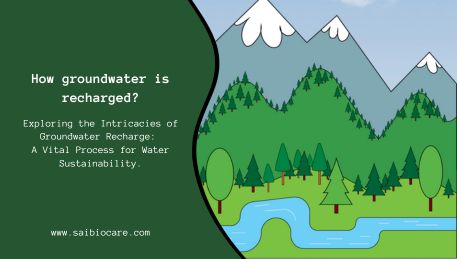
Under the Earth’s surface lies an intricate network of porous rocks and soil that store an invaluable resource—groundwater. This hidden reservoir serves as a lifeline for human consumption, agriculture, and ecosystem support. Understanding how groundwater is recharged is crucial in ensuring its sustainability, especially in the face of increasing water scarcity and the impact of human activities on natural water cycles.
Groundwater Recharge: A Natural Process
Groundwater recharge is the natural process by which water infiltrates through the soil and percolates downward to replenish underground aquifers. This replenishment occurs primarily through precipitation, which includes rainfall, snowmelt, and surface water infiltration.
Natural Mechanisms of Groundwater Recharge
1. Infiltration:
When rain falls or snow melts, water seeps into the ground, aided by gravity, porous surfaces like soil, gravel, and permeable rocks allow water to penetrate the Earth’s surface.
2. Percolation:
Once water infiltrates the soil, it moves downward due to gravity, slowly permeating through layers of rock and sediment. This percolation process is critical in refilling aquifers.
3. Interconnected Water Cycle:
Groundwater recharge is closely linked to the water cycle. As surface water bodies like rivers, lakes, and streams receive precipitation, excess water can seep through the ground, recharging aquifers and maintaining a balance in the water cycle.
Factors Influencing Groundwater Recharge
1. Geology and Soil Composition:
The permeability and porosity of soil and rock formations greatly influence the rate and effectiveness of recharge. Highly permeable materials allow water to infiltrate more readily than compacted or impermeable surfaces.
2. Land Use and Human Activities:
Urbanization, deforestation, and land development significantly impact recharge rates. Paved surfaces and altered landscapes reduce natural infiltration, impeding groundwater replenishment.
3. Climate and Precipitation Patterns:
Regions experiencing high precipitation rates or regular snowmelt tend to have more effective recharge. Changes in precipitation patterns due to climate change can alter recharge dynamics.
Methods of Groundwater Recharge
1. Natural Recharge:
Preserving natural landscapes, such as forests, wetlands, and grasslands, helps maintain natural recharge processes. Vegetation and permeable surfaces facilitate infiltration and percolation.
2. Artificial Recharge:
Artificial Groundwater Recharge methods play a significant role in supplementing natural recharge. Some techniques include:
-Recharge Wells: These wells allow surface water or treated wastewater to infiltrate directly into aquifers.
–Spreading Basins and Percolation Ponds: Constructed basins or ponds designed to capture surface water and allow it to percolate into the ground.
–Rainwater Harvesting: Rainwater harvesting includes capturing and storing rainwater for later infiltration into the ground through various means like rooftop rainwater collection, rain gardens, and permeable pavements that aid in groundwater recharge.
Despite its significance, groundwater recharge faces challenges:
1. Urbanization and Land Use Changes:
Rapid urban development and changes in land use disrupt natural recharge processes, decreasing infiltration rates.
2. Climate Change:
Altered precipitation patterns and increased evaporation due to rising temperatures impact the timing and quantity of water available for recharge.
3. Quality Control:
Ensuring that recharged water maintains good quality is crucial. Proper treatment and filtration are essential, especially when using treated wastewater for recharge purposes.
However, innovative solutions and advancements offer hope for effective groundwater recharge:
1. Smart Land Use Planning:
Implementing permeable surfaces, green spaces, and preserving natural recharge areas in urban planning can enhance natural recharge processes.
2. Technological Advancements:
Continued advancements in water treatment technologies enable the safe and effective use of wastewater treatment for recharge purposes.
Conclusion:
Groundwater recharge stands as a cornerstone of water sustainability. Understanding the intricacies of this process, from natural mechanisms to human interventions, is imperative in ensuring the availability and quality of this vital resource.
By implementing sustainable practices, embracing innovative technologies, and fostering a deeper understanding of the factors influencing recharge, we can protect and replenish our groundwater reserves. Groundwater recharge isn’t merely a process; it’s a commitment to preserving this invaluable resource for current and future generations, safeguarding the balance of nature’s water cycle.
